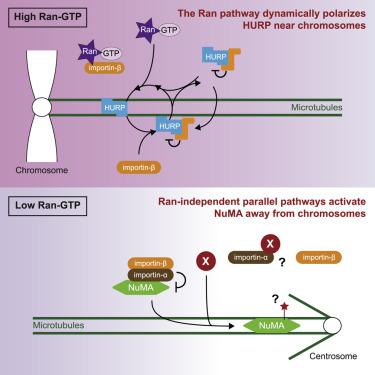Current Biology ( IF 8.1 ) Pub Date : 2020-11-12 , DOI: 10.1016/j.cub.2020.09.091 Kenta Tsuchiya 1 , Hisato Hayashi 1 , Momoko Nishina 1 , Masako Okumura 1 , Yoshikatsu Sato 1 , Masato T Kanemaki 2 , Gohta Goshima 1 , Tomomi Kiyomitsu 3

|
Spindle assembly is spatially regulated by a chromosome-derived Ran- GTP gradient. Previous work proposed that Ran-GTP activates spindle assembly factors (SAFs) around chromosomes by dissociating inhibitory importins from SAFs. However, it is unclear whether the Ran-GTP gradient equivalently activates SAFs that localize at distinct spindle regions. In addition, Ran’s dual functions in interphase nucleocytoplasmic transport and mitotic spindle assembly have made it difficult to assess its mitotic roles in somatic cells. Here, using auxin-inducible degron technology in human cells, we developed acute mitotic depletion assays to dissect Ran’s mitotic roles systematically and separately from its interphase function. In contrast to the prevailing model, we found that the Ran pathway is not essential for spindle assembly activities that occur at sites spatially separated from chromosomes, including activating NuMA for spindle-pole focusing or for targeting TPX2. On the other hand, Ran-GTP is required to localize HURP and HSET specifically at chromosome-proximal regions to set proper spindle length during prometaphase. We demonstrated that Ran-GTP and importin-β coordinately promote HURP’s dynamic microtubule binding-dissociation cycle, which maintains HURP near chromosomes during metaphase. Together, we propose that the Ran pathway acts on spindle assembly independently of its interphase functions in mitotic human cells but does not equivalently regulate all Ran-regulated SAFs. Ran-dependent spindle assembly is likely coupled with additional parallel pathways that activate SAFs distantly located from the chromosomes.
中文翻译:

Ran-GTP 对于激活 NuMA 以进行有丝分裂纺锤极聚焦不是必需的,但在染色体附近动态极化 HURP
纺锤体组装受染色体衍生的 Ran-GTP 梯度空间调节。先前的工作提出,Ran-GTP 通过将抑制性输入蛋白与 SAF 分离来激活染色体周围的纺锤体组装因子 (SAF)。然而,尚不清楚 Ran-GTP 梯度是否等效地激活定位于不同纺锤体区域的 SAF。此外,Ran 在间期核质运输和有丝分裂纺锤体组装中的双重功能使其难以评估其在体细胞中的有丝分裂作用。在这里,我们在人类细胞中使用生长素诱导的 degron 技术,开发了急性有丝分裂耗竭测定法,以系统地剖析 Ran 的有丝分裂作用,并将其与其间期功能分开。与主流模式相比,我们发现 Ran 通路对于发生在与染色体空间分离的位点的纺锤体组装活动不是必需的,包括激活 NuMA 进行纺锤体极点聚焦或靶向 TPX2。另一方面,Ran-GTP 需要将 HURP 和 HSET 定位在染色体近端区域,以在前中期设置适当的纺锤体长度。我们证明 Ran-GTP 和 importin-β 协同促进 HURP 的动态微管结合-解离循环,从而在中期维持染色体附近的 HURP。总之,我们提出 Ran 通路独立于其在有丝分裂人类细胞中的间期功能作用于纺锤体组装,但并不等效地调节所有 Ran 调节的 SAF。











































 京公网安备 11010802027423号
京公网安备 11010802027423号